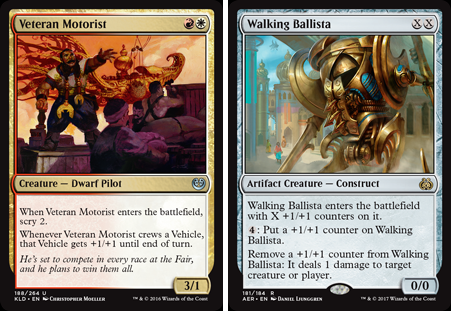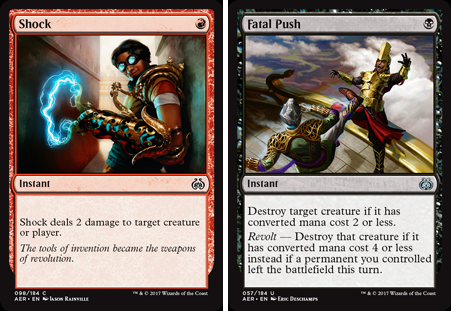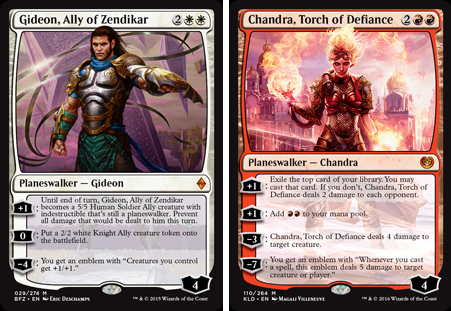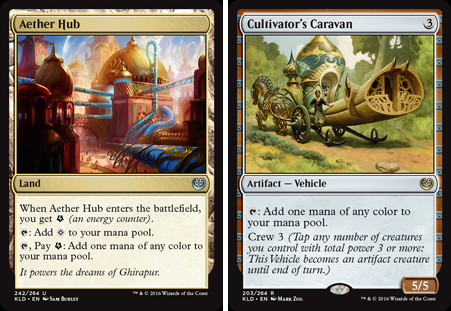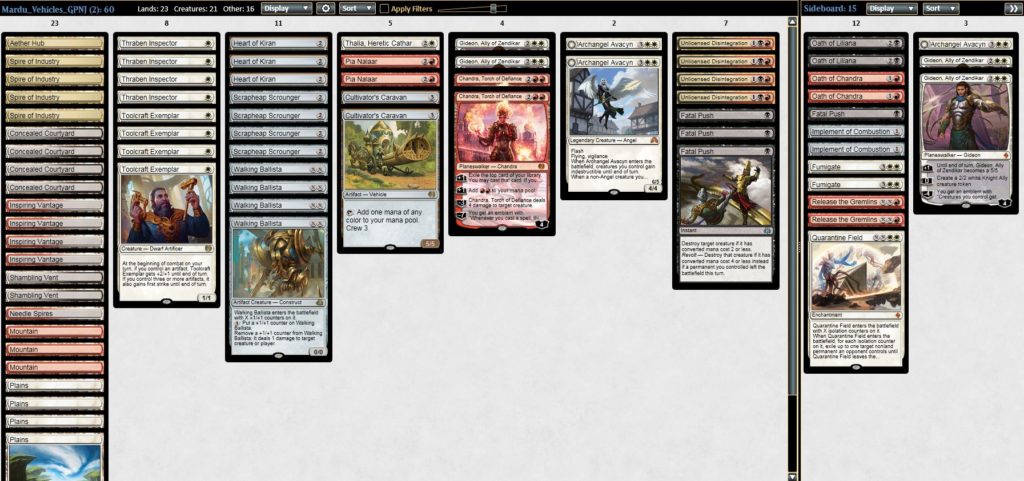GP New Jersey ended up being my most successful Grand Prix to date for a number of reasons.
- Record – It was my best finish by record, going 12-3. This was good enough for Top 32, though I conceded Round 15 to officially finish 11-4.
- Deck Selection – After much indecision, I’m confident that I chose the best deck for the event – Mardu Ballista.
- Mental State – Perhaps the best accomplishment was that this was the best I felt or played throughout a GP Day 2.
Tournament Prep: Deck Selection
As has unfortunately been my pattern lately, I had a hard time locking in a deck for GP New Jersey. By now I think that Mardu Ballista is the consensus best deck in the format. Heading into the weekend, it was only clear that Mardu, 4C Saheeli and (to a lesser extent) GB were the three best decks. I played a lot of different decks in standard over the course of the format so I had a good feel for the different options but I didn’t know where I wanted to land for the weekend.
I built Mardu at the end of the last standard but never even got to play it before putting it aside early in the new standard season when GB was king. The combination of Fatal Push and Walking Ballista meant that I just assumed Mardu wasn’t well positioned when the field was dominated by GB. Then Mardu broke out at the Pro Tour, many of the pros proclaimed that GB wasn’t even a good deck and everything I thought I knew was called in question.
I had been trying all manner of Spell Queller decks. Queller had felt well positioned but with UW Flash not being a deck anymore, the card didn’t really have a home. At one point I was even testing 4C vehicles – Mardu plus Spell Queller and other blue counter-magic. Queller does a lot of work against Saheeli and GB, but with the field shifting more and more towards Mardu, Queller wasn’t as well positioned anymore. The payoff just wasn’t very high since Mardu has a lot of ways to kill the Queller and the spirit isn’t a great pilot for Heart of Kiran.
I tried GB Energy for a little while. I preferred the low to the ground aggro build of the deck with Greenbelt Rampager. It felt like the best way to pressure Mardu and get under the control elements of Saheeli and Tower decks.
The Walking Ballista version of Mardu had popped up on Magic Online but I wasn’t yet convinced that it was better than the Veteran Motorist versions. It seemed less aggressive and made it even harder to crew the important vehicles (namely Heart of Kiran). My experience was that Mardu was already inconsistent because of its mana, so I didn’t like the added inconsistency of making crewing more difficult. Once the deck took the top 2 spots at GP Utrecht I knew I had to take it seriously.
Temur Tower was an archetype also making waves after noted pro and control deckbuilder Shota Yasooka went undefeated with it in an online league. Some pros also took the Tower deck to GP Utrecht. Even though it didn’t top 8 the event, it did put the deck in the spotlight going into New Jersey.
In the final week of preparation, I proxied a gauntlet of the top decks: Mardu Ballista, 4C Saheeli, GB Energy, Temur Tower. I also included two brews: my own Esper Vehicles (essentially the BW vehicle core with Spell Queller and other counterspells in the sideboard) and a Sultai Delirium brew I found on Reddit (a GB Delirium control deck that splashed blue for Torrential Gearhulk).
Combining playtesting and my experience with the format, my conclusions were:
- Mardu Vehicles – The power level here was just very high. Every card is powerful and efficient. The sideboard plan meant that the deck could play well into the late game. The nut draws were impossible for other decks to beat most of the time.
- 4C Saheeli – A good deck but I didn’t want to play the grindy games it would require. The combo was powerful but I found the backup plan of Rogue Refiners and Whirler Virtuoso to be lacking most of the time. (Since then, I think the more recent innovations of playing Traverse the Ulvenwald and Ishkanah, Grafwidow are much more compelling). Virtuoso was an important part of the deck’s plan since it bought a lot of time against Mardu or GB to be able to find the combo.
- GB Energy – Competitive against Mardu, but I don’t think it’s a heavy favorite or a lopsided matchup. The biggest drawback to the deck was the Saheeli matchup. It felt like Ballista was the only card that really mattered. In a lot of games Saheeli could buy time with Virtuoso thopters until it found an answer for Ballista and was then able to combo.
- Temur Tower – Built to exploit Mardu Vehicles. It had a pretty good matchup, but even this deck struggled to keep up against the nut draws from Mardu. There were also times where the Tower deck couldn’t handle the recursion of Scrapheap Scrounger. The Saheeli matchup was pretty good but it struggled against GB because all of the GB threats were so good on rate – it’s actually pretty hard to kill a Greenbelt Rampager or Longtusk Cub.
- Esper Vehicles – This has tested well for me against GB and 4C Saheeli. The counterspells and flash elements help it hold up against Torrential Gearhulk decks as well. The problem is that it couldn’t reliably beat Mardu. Esper basically trades a Murder that deals the opponent 3 damage (Unlicensed Disintegration) for a murder that deals yourself 3 damage (Anguished Unmaking). I like this deck in a meta where Mardu isn’t prevalent, but that’s definitely not where we are at right now.
- Sultai Delirium – I only got to play a few games with this deck, but it was powerful and really sweet. I think it had potential, but I didn’t have time to test or tune it thoroughly.
Choosing Mardu
As late as Wednesday night before the GP I hadn’t picked a deck yet. I played close to a dozen games against a friend on GB and I just wasn’t winning with anything. I felt deflated and was at a loss for what to play on the weekend. I was not optimistic about my chances for success at this point.
I decided Mardu hit all the right notes that I look for in a deck. It’s proactive with some ‘free wins’ from unbeatable nut draws. Besides the nut aggro draws, it can still grind out wins into the late game, especially after sideboard where it can switch gears with more Planeswalkers and removal. The biggest downside to the deck was definitely the mana. Spire of Industry helps tremendously but things aren’t always easy for a 3-color aggro deck.
My biggest reservation with this deck choice was that it was the deck with the biggest target on its back. It was sure to be popular at the event and players would be prepared for it. I don’t have a problem playing the expected deck, but when I do I like to have some tech or a solid plan for the mirror. I didn’t have that this time and since I had waited so long to decide on a deck I wouldn’t have time to test it much or tune it to my liking.
Tournament Prep: Tuning Mardu Vehicles
I spent the final 48 hours trying decide on the last few cards in the Mardu build. Paulo Vitor Damo da Rosa outlined the deckbuilding considerations pretty well here: Which Mardu List Should You Play? Between his article, the Utrecht top 8 lists, my playtesting, opinions on Twitter and Michael Majors streaming his own testing of Mardu I came to my final build. Some of my decisions were definitely unconventional. I’m willing to be wrong, but the most important thing to me is that I feel comfortable with how I built my deck and how I expect the games to play out. Having some agency with the deckbuilding is a big deal to understanding how the deck works and what your game plan is in certain matchups or board states.
Veteran Motorist vs. Walking Ballista
This one was easy to settle. I thought I wanted Motorist to be more aggressive and to reliably crew Heart of Kiran. I understood the desire to replace Motorist with Ballista because it was easier to cast which let you skew the manabase in favor of black to play Fatal Push. But I was leaning toward going back to a more RW version of the deck anyway so I thought I wanted Motorist again. After playing a few matches I decided Motorist was too much of a liability because every single deck in the format had either Walking Ballista or thopters from Whirler Virtuoso.
Shock vs. Fatal Push
Fatal Push is certainly the better card most of the time. That said, I didn’t expect a lot of GB at the Grand Prix and thats where you really want Fatal Push. Shock is only slightly worse in the mirror with the big downside being that it can’t kill Heart of Kiran. Shock is a big upgrade however against 4C Saheeli where Fatal Push is close to a dead card.
I was set on playing 3 Shocks and zero Fatal Push. I was making this choice based on the 2-deck metagame I expected at the Grand Prix. The night before, after seeing GB around during some of the Friday side events, I made the last minute decision to play 3 Fatal Push instead of the 3 Shocks. I had to remind myself that even if you expect a certain deck or decks to be over-represented at a Grand Prix, there are many players who just bring whatever deck they have and you can play against anything in an open field. For that reason I hedged by playing Fatal Push.
For the most part, these two cards were interchangeable during the tournament. But funnily enough, in the very first game on Day 1 I drew x2 Fatal Push when my opponent was at 2 life and I lost.
Gideon, Ally of Zendikar
This is easily the most controversial decision I made so I might as well confess to it openly. To the shock and dismay of every other Mardu player I’ve talked to, I only played x2 Gideon, Ally of Zendikar in my main deck. Considered by many to be the best card in the format, it has even been discussed whether Gideon should be banned. So why would I only play two?
In my experience, there are a lot of games where you are under too much pressure to profitably play a Gideon on turn 4. On the draw in the mirror, a turn 4 Gideon often feels not that much better than a 4-mana fog. The same is sometimes true against a turn 3 Whirler Virtuoso – the thopters can pressure Gideon very effectively.
I had the feeling that I wanted to cut down from the full x4 Gideon but it wasn’t until I read Paulo’s article that I had the confidence to do so. He mentioned that Gideon is often one of the first cards he trims on when on the draw. My thinking was that if the value of Gideon changes so much on the play vs. on the draw, you are only going to be on the play for game one 50% of the time. I trimmed down to x2 Gideon in the main as a hedge against the coin flip and put the other two in the sideboard. You want access to the full four after sideboard, not only based on play/draw but also because the games tend to slow down as players stock up on removal.
In Gideon’s place I played x2 Chandra, Torch of Defiance. Chandra is much better when behind so she can help you catch up on the draw. This is where I got a huge advantage from playing a RW manabase even though I had decided not to play Motorist or Shock. Most players in the mirror were still on the BW version (without Caravan) to support Fatal Push and didn’t have access to Chandra. It turned out that many players showed up with x2 Nahiri, the Harbinger in their sideboard. When I asked Owen Turtenwald about it later, he said that Nahiri was essentially a poor man’s Chandra – he would prefer to play Chandra but the mana just didn’t support it.
I haven’t talked to anyone that agrees with me on this change, but I’ve kept it even after the Grand Prix and have been very happy with this choice. I killed my fair share of Gideons in the tournament that just felt like small speed-bumps to my aggressive start.
The Manabase
Most lists played either 23 or 24 lands. I wanted to play as few lands as necessary just because it’s really hard to make the last few cuts in this deck – all of the cards are so good. It’s hard to balance the number of vehicles with the number of pilots and non-creature spells like removal and Planeswalkers. You also need enough artifacts to keep Spire of Industry and Unlicensed Disintegration turned on.
I liked the idea of having more mana sources, especially with some expensive spells in the sideboard. On the other hand, I was afraid of losing games by flooding out and wanted to keep my spell density high if possible.
Besides the number of lands, I had to consider my mana fixing. My mana was initially going to be heavily RW-based. My decision to play Fatal Push threw a wrench in these plans.
The solution to both problems was to play two Cultivator’s Caravan. The games where you can play a turn 3 Caravan into a 1-mana spell like Exemplar or Fatal Push makes you feel so far ahead. With 23 lands, this gave me 25 mana sources and helped fix my mana for Fatal Push. The caravan is a mana-source early while being a large threat when needed. Plus it counted as an artifact to turn on the rest of the deck. My build can even make use of ramping to 5-mana by playing an Archangel Avacyn or ramping to a turn 4 Fumigate against GB. The only downside was giving your opponent more Release the Gremlin targets after sideboard, but otherwise the Caravans did everything I was looking for and I’m surprised more people don’t play them.
Aether Hub on the other hand is a card I hate. Without Harnessed Lightning or Aethersphere Harvester there are no other sources of energy. I found that in most games I only needed to use the Hub for colored mana once, so I didn’t mind drawing the first one, but drawing multiples was always bad. Going to 23 lands let me play only a single Aether Hub.
The Sideboard
By the time I decided on Mardu I didn’t have time to play many games and actually test it and create a sideboard plan of my own. I mostly copied stock sideboards from other lists with a couple of my own tweaks. One thing that stands out is that the sideboard is mostly answer cards instead of threats. The maindeck is very proactive and contains all the threats you need. The sideboard helps fill out your deck with the right answers for the matchup but you shouldn’t oversideboard. Make sure to keep enough threats in your deck after sideboard.
Instead of Shocks in my sideboard for Saheeli I played x2 Implement of Combustion. I think I saw this in a Michael Majors stream and I liked it better than either Shock or Authority of the Consuls. Being an artifact is a huge deal because it helps fix your mana with Spire of Industry. I actually had one hand at the GP that I could only keep because I had a basic Mountain, a Spire as my only white source and the implement to turn it on. It’s also an answer to the combo that you can cycle if you need more action and it works well with Pia which I was running as a 2-of.
My only other tech was to play a single Quarantine Field. This was for GB and to answer Planeswalkers in the mirror. Others had a Sorin, Grim Nemesis in that slot but I liked having the option to cast Quarantine Field on four mana and the fact that it straight answered two permanents right away. Against GB, a Sorin can’t always even 1-for-1 against something like a Verdurous Gearhulk. At the time, Natural Obsolescence was seeing play over Natural State and Mardu lists weren’t playing Nahiri, the Harbinger (though Owen and others did bring them as an innovation in New Jersey). Q-Field was great for me on the weekend but I wouldn’t play it now and have since replaced it with Sorin.
GP Decklist – Mardu Vehicles
Mardu Vehicles
| Creatures (21) 4 Toolcraft Exemplar 4 Thraben Inspector 4 Scrapheap Scrounger 4 Walking Ballista 2 Pia Nalaar 1 Thalia, Heretic Cathar 2 Archangel Avacyn Vehicles/Planeswalkers (9) 3 Heart of Kiran 2 Cultivator’s Caravan 2 Gideon, Ally of Zendikar 2 Chandra, Torch of Defiance Spells (7) 3 Fatal Push 4 Unlicensed Disintegration | Lands (23) 4 Spire of Industry 1 Aether Hub 4 Concealed Courtyard 4 Inspiring Vantage 1 Needle Spires 2 Shambling Vent 4 Plains 3 Mountain Sideboard (15) 2 Implement of Combustion 1 Fatal Push 2 Oath of Chandra 2 Oath of Liliana 2 Fumigate 2 Release the Gremlins 1 Quarantine Field 2 Gideon, Ally of Zendikar 1 Archangel Avacyn |
GP Day 1
R3, 3-0 – Temur Marvel (W, 2-1)
R4, 4-0 – 4C Saheeli (W, 2-1)
R5, 5-0 – 4C Saheeli (W, 2-0)
R6, 6-0 – GB (W, 2-0)
R7, 7-0 – 4C Saheeli (W, 2-1)
R8, 7-1 – Mardu Ballista (L, 1-2)
R9, 8-1 – Mardu Vehicles(W, 2-1)
I started the day without a lot of expectations since I only got to play 1 match with my final build prior to the tournament. That was a Last Chance Trial event where I lost the first round to a turbo-fog deck that played Providence and Wildest Dreams. After that I refused to play anymore matches on Friday.
I was able to run up a satisfying 8-1 and most games didn’t feel particularly difficult. My openings hands were decent all day, I started on T1 Exemplar a decent amount, my mana cooperated and the top of the deck was kind in a couple of key spots. If my notes are correct, I only mulliganed once in all of day 1.
I played against 4 Whirler Virtuoso decks in the first 5 rounds and beat them all pretty soundly. The combination of pressure and lots of ways to disrupt the combo has made the matchup feel very favorable. The Implement of Combustion proved its worth in my first match where I thought my opponent was on 4C Saheeli based on what I saw. I noticed that he was choosing not to make thopters in response to removal on his Virtuoso in games 1 and 2, which I thought was really strange. It turned out that my opponent was actually playing an Aetherworks Marvel deck. If I had realized that at any point, I could’ve cycled the implement. As it turns out, my opponent drew multiple Ulamogs and zero Marvels during our entire match.
I only played against one GB opponent on the day and my opponent was a GP grinder (Jonathan Sukenik) who had below average draws. After my opponent was manascrewed in game 1 (on 3 basic swamps) I drew well in game 2 with a sideboard Fumigate and three Unlicensed Disintegration. I felt fortunate to come away with an easy win against a tough matchup and a good player.
It wasn’t until the 7-0 bracket where I started running into mirror matches. After winning game 1, it was in game 2 when my opponent played Painful Truths on the play that my fears were justified and I realized I had know idea how to sideboard for the mirror. I knew I would have to give more thought to it and hopefully get more games in overnight to be ready for day 2. My opponent needed every card to win a close game 2, so the card draw spell was vital. In game 3 I got blown out by a Release the Gremlins killing both of my Caravans.
I ended up winning a very tight mirror in round 9. My opponent was playing Motorist, which I felt gave me a slight advantage. I started game 3 on the draw but got my opponent down to 2 cards in hand vs. my 4 or 5. A timely Release the Gremlins hit two of my Scroungers and a thopter to stabilize the board for my opponent. From there it was a close damage race. With a couple removal spells in hand, I ended up taking the damage on an aggressive attack from my opponent and going to down to 2 life. I spent my last available life point using Spire of Industry to return a Scrounger and I was able to kill enough of my opponent’s blockers to attack for lethal. I drew a few more spells than he did in the last couple of turns and used my life total as a resource. Taking the damage was a calculated risk, knowing that I probably couldn’t beat a Disintegration anyway. It was a little easier since I knew my opponent was playing Motorist instead of Ballistas.
This final win of the day was pretty sweet because it was such a close game and a bunch of friends had come over to watch it. Afterwards we went to dinner. I discussed sideboard plans with Jake Haversat, who was also playing Mardu for the weekend, and came up with a slightly different strategy going into day 2. I would take out all of my vehicles to reduce the targets for Release (I was already taking out Hearts but now I would take out Caravans too) and I would try bringing in the Oath of Liliana instead.
GP Day 2
R10, 8-2 – GB Energy (L, 0-2)
R11, 9-2 – Mardu Ballista (W, 2-0)
R12, 9-3 – Mardu Ballista (L, 0-2)
R13, 10-3 – RB Zombies (W, 2-0)
R14, 11-3 – 4C Saheeli (W, 2-1)
R15, 11-4 – Mardu Ballista (Concession)
My luck didn’t carry over to a great start on day 2. Playing against GB in the first round of the day I couldn’t cast my spells in either game. After keeping 2 lands I drew no lands but three Ballistas, the worst card in the matchup. In game 2 I kept two lands, drew a Plains which didn’t let me cast either of my black spells, and then drew a fast land on turn 4 which meant I couldn’t cast my Gideon on curve.
In round 11 I got back on track in a mirror where I finally got to be on the good side of a Release the Gremlins for the first time of the weekend. My mana troubles resurfaced in round 12 though in a mirror against Noah Walker. Noah had the nuts on the play in game 1 and then I mulliganed into a non-functional hand in game 2.
I did win out the last 3 rounds, beating 4C Saheeli one more time for a perfect record in the matchup on the weekend. I also beat Timothy Wu, a pro from team East/West Bowl, in the Mardu mirror in round 15. I had already conceeded to him since I don’t need the pro points, but we played the match out anyway. After it was over, we discussed the matchup and both admitted that we had no idea how to sideboard in the mirror.
Overall this was how I fared against each matchup:
GB: 1-1
Mardu: 3-2
4C Saheeli: 4-0
Other: 2-0
Conclusion
This Grand Prix was a big success for me. I felt like I played pretty well all weekend. Not perfectly, for sure, but on the whole I chose a great deck, got a little lucky and played some pretty good Magic. I felt great all weekend, right through the end of round 15 – a first for me in these long two-day events. Unfortunately I have to admit that it helps not to go out late having drinks at the end of day 1.
There were no big metagame shakeups at the tournament, which made my preparation and deck/card choices look wise. I played Mardu or 4C Saheeli in 9 out of 13 rounds. GB was around in small numbers, but once at the top tables it was a lot of Mardu. I know ‘stale’ or ‘solved’ formats are not appreciated by many players, but as a competitive player I’ve come to like the predictability of a solved format. When I go to a Grand Prix, it makes it much easier to prepare for a format that has 2 or 3 decks that you can expect to face a lot. It might not be exciting to some, but I enjoy finding the small edges that you can gain by mastering those matchups, bringing some unexpected sideboard tech and knowing that your hours of practice will actually pay off in the event.
On the decision to only play two Gideon, I can’t say I regretted it. Chandra was very good for me and there was only one game where I couldn’t cast her. I drew her in a game 1 against GB and was able to control the board better than if I had Gideon. I can also say my opponents played a few Gideons that were trivial to answer. A removal spell on the knight (especially if it’s Disintegration) and Gideon was swatted away like an annoying mosquito.
The real over-performer on the weekend was Oath of Chandra. In sideboarded games that revolve around Planeswalkers, an Oath in play means that the first player to land a Planeswalker is almost at a disadvantage. If your opponent plays Gideon and makes a knight, the Oath deals two to your face. If you are able to play Chandra, plus to deal two to Gideon and trigger the Oath to kill Gideon you are extremely far ahead.
I feel like it’s a mistake not to play Mardu right now, at least until a new set changes the format. The format is not very diverse, but I do find the games really interesting to play. Sideboarding isn’t easy and there are a lot of decisions to make. Against non-Mardu decks I just played my cards, kept myself protected from the combo when possible, and won pretty easily. I ended up 3-2 in the Mardu mirror and I’m not sure how much I really learned. As long as neither play stumbles the games can go pretty long; the red oath is a huge advantage in the Planeswalker war. Painful Truths is definitely a card I want to add as a 1-of.
In two of my three overall losses, I really didn’t get to cast spells and play Magic. The only close loss I took on the weekend was in round 8. When the mana cooperates, the Mardu deck is very powerful and hard to beat. That’s why I chose it going into the tournament and it played out even better than I expected. With a little more luck, I could easily have seen myself making the top 8 of this tournament. That’s not something I would have expected to say a year ago so it’s really encouraging to feel that a Grand Prix top 8 is actually achievable for me now.
Follow me on Twitter @thenatewalker.
Follow my Twitch channel: www.twitch.tv/n_walker. I stream a lot of limited, some standard/modern.
Or reach me in the comments below!

